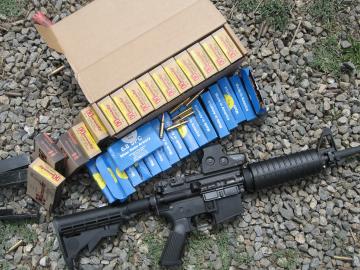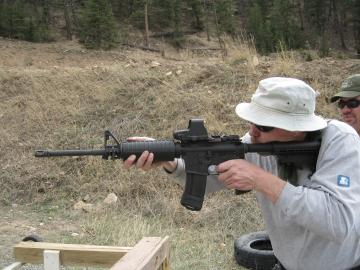

The Model 5 is shown with 600 rounds of factory ammunition from
Hornady and Silver State Armory. Another 200 rounds of the author's
hand-loads were also used during the practical testing.
To test the accuracy of the Stag carbine, I shot a series of five to
ten, five-shot groups with each of the Hornady 110-grain OTM, Silver
State 115-grain SMK, and Silver State 110-grain Pro-Hunter factory
ammunition, and my reloads. The Stag carbine had no problem shooting
consistent 0.75 to 1.75 minute of angle (MOA) groups at 100 meters.
The winds during the accuracy testing were pretty typical for my
high-plains locale, variable five to 15 mph. I did notice that as the
chrome-lined barrel had more rounds fired, it seemed to settle down
and provide better groups on average than when new. Throughout the
over 200 rounds fired in the accuracy tests, the reliability of the
Stag carbine was consistent.
Static accuracy and reliability tests serve their purpose, but the
M4-style Stag carbine is designed for light weight and maneuverability
in practical applications like defense and sport. To get a feeling
for how the Stag carbine performs in its natural setting, three other
competitive shooters and I shot the Stag carbine side by side with
other rifles in a practical shooting course requiring speed, accuracy,
and movement. The comparison rifles were: a 20-inch AR-15A2 in .223
set up with iron sights and a JP Enterprises BC muzzle compensator; a
16-inch AK-47 in 7.62x39mm; a 16-inch Barrett M468 in 6.8 SPC; and a
18-inch MSTN in 6.8 SPC with a MSTN QC muzzle compensator.


The Model 5's hand-guards are easy to grasp, and their metal
heat-shields are welcome during rapid-fire drills. The carbine proved
reliable even when its barrel was too hot to touch.
The first course of fire comprised four steel silhouette targets
arranged at 40 yards, which the shooter engaged once each from three
positions: through a low port, touching a barricade, and over a tire.
The positions were about five yards apart, so the shooters had to
move. The Stag 6.8 SPC carbine was very handy for this course of
fire. Its light weight, natural pointing, and short length were
advantages which helped the shooters transition to the next target
after each shot, and move quickly to the next position.
After shooting the first drill, we decided to use another test to
focus more on the specific handling characteristics of the rifles.
Starting with the muzzle touching the barricade, the shooter was to
double-tap each steel target once, for a total of 8 shots on the four
targets. This drill exposed the recoil characteristics of the
different rifles, how much the sight picture was disturbed, and target
transition handling. Here, the Stag carbine's light weight and A2
flash hider worked against it, bouncing us around noticeably more than
the other rifles. We had to deliberately slow down and man-handle the
gun to stay on target for the second shots, compared to the other
rifles which generally stayed on target and didn't push the shooter
around in recoil.
|